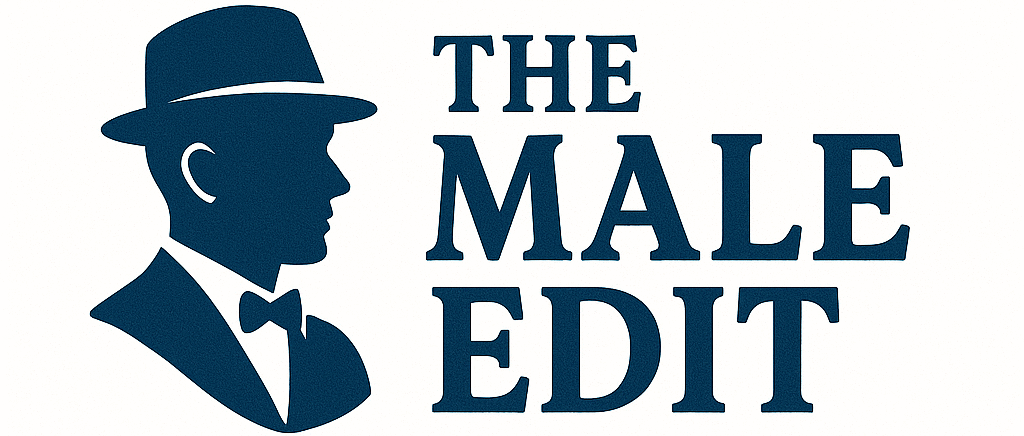Growing a full thick beard isn’t always in the cards for every man. If you’re dealing with patchy facial hair you’re definitely not alone – millions of men face the same challenge when trying to achieve their ideal beard look.
The good news? A patchy beard doesn’t mean you can’t rock an impressive facial hair style. We’ve discovered that working with your natural growth patterns rather than against them creates the most flattering and confident looks.
From strategic trimming techniques to choosing the right beard style for your exact patch patterns we’ll show you how to transform what you might see as a limitation into your signature look. Whether you’re dealing with sparse cheek coverage or uneven growth around your jawline there’s a perfect patchy beard style waiting for you to discover.
Understanding Patchy Beard Growth and Why It Happens
Patchy beard growth affects about 70% of men at some point in their facial hair journey. We’ll explore the science behind uneven growth patterns to help you work with your natural hair distribution.
Genetics Play the Biggest Role in Beard Density
Genetics determine up to 85% of your beard’s growth pattern and density. Your DNA controls how many hair follicles you have on your face and where they’re located. Family history provides the clearest indicator of your potential beard growth – if your father or grandfather had patchy areas around the cheeks or jawline, you’ll likely experience similar patterns.
Follicle distribution varies significantly between ethnic groups and individuals. Men of East Asian descent typically have fewer facial hair follicles overall, while Mediterranean and Middle Eastern men often have denser growth but may experience patches in exact areas like the upper cheeks. The androgen receptor gene specifically influences how your hair follicles respond to testosterone, creating unique growth maps that remain consistent throughout your life.
Hair follicle angles also impact how full your beard appears. Some follicles grow hair at sharp angles that create gaps between strands, while others produce hair that grows straight out for maximum coverage. This genetic variation explains why two men with similar follicle counts can have dramatically different beard appearances.
Hormonal Factors That Affect Facial Hair Growth
Testosterone levels directly influence beard thickness and growth speed. Men with higher testosterone typically experience faster hair growth and thicker individual strands, though this doesn’t guarantee even distribution. Dihydrotestosterone (DHT) plays an even more crucial role by binding to hair follicles and triggering the growth phase.
Hormonal imbalances can create or worsen patchy areas. Thyroid disorders affect about 12% of men and can slow facial hair growth significantly. Stress hormones like cortisol interfere with the hair growth cycle, potentially causing existing patches to become more pronounced during high-stress periods.
Insulin sensitivity impacts beard development in unexpected ways. Men with insulin resistance may experience slower beard growth and increased patchiness, particularly in the neck and lower jawline areas. Regular exercise and balanced nutrition help optimize hormone levels for better facial hair development.
Age and Beard Development Patterns
Beard growth continues developing well into your thirties and beyond. Most men reach peak facial hair density between ages 25-35, with some areas filling in as late as age 40. The cheek area typically takes the longest to develop, often appearing sparse until the mid-twenties.
Growth phases change throughout different life stages. Teenage beards usually show the most dramatic patchy patterns, with important improvement occurring in the early twenties. Men in their forties may notice changes in hair texture and color but often achieve their fullest coverage during this decade.
Seasonal variations affect beard growth cycles throughout the year. Hair grows approximately 15% faster during summer months due to increased vitamin D production and improved circulation. Winter growth tends to be slower but produces thicker individual hairs, which can help disguise patchy areas naturally.
The Classic Goatee: Perfect for Sparse Cheek Coverage
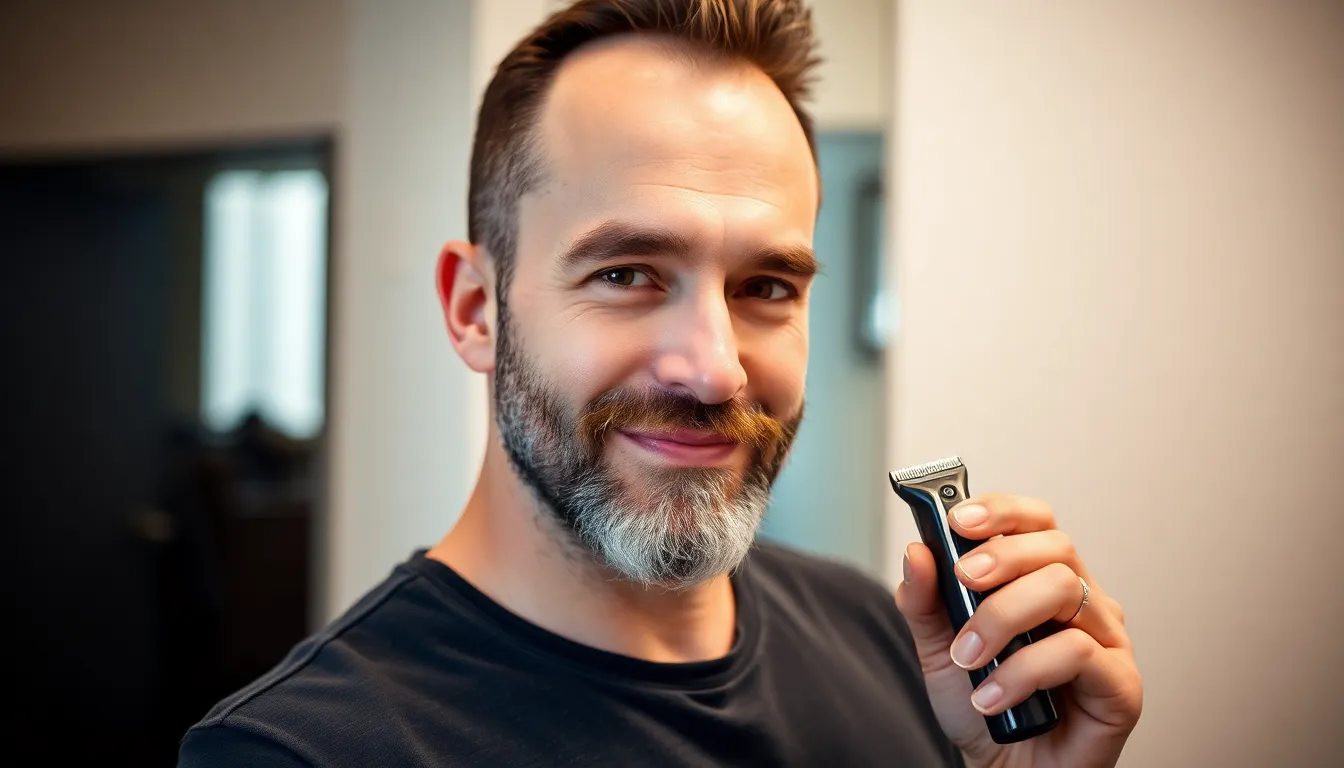
We’ve found that the classic goatee stands out as one of the most effective answers for men dealing with patchy cheek coverage. This timeless style strategically focuses growth around the chin area while keeping problematic cheek zones cleanly shaven.
Traditional Goatee Styling Techniques
Trimming forms the foundation of any well-executed goatee style. We recommend maintaining a uniform length across the entire goatee area using quality clippers with adjustable guards. Regular trimming sessions every 3-4 days prevent uneven growth patterns that can make sparse areas more noticeable.
Shaping requires precision to create clean, defined edges that draw attention to your strongest growth areas. Use a trimmer with a narrow blade to outline the goatee’s perimeter, ensuring sharp lines along the jawline and chin. Professional barbers suggest marking the boundaries with a washable marker before trimming to avoid mistakes.
Combining with mustache creates a cohesive look that balances facial proportions effectively. Ensure the mustache and goatee maintain symmetrical dimensions and complementary lengths. We’ve observed that connecting these elements through careful grooming creates visual continuity that minimizes attention to patchy cheek areas.
Maintenance Tips for a Sharp Goatee Look
Regular trimming schedules keep your goatee looking intentional rather than unkempt. We suggest establishing a weekly maintenance routine that includes edge cleanup and length adjustment. Professional stylists recommend trimming when hair is dry to achieve more accurate results.
Beard care products specifically designed for facial hair health make a important difference in appearance quality. Apply beard oils containing jojoba or argan oil to nourish both hair follicles and underlying skin. We’ve found that using dedicated beard washes prevents skin irritation while maintaining natural oils that promote healthy growth patterns.
The Stubble Approach: Embracing Minimal Growth
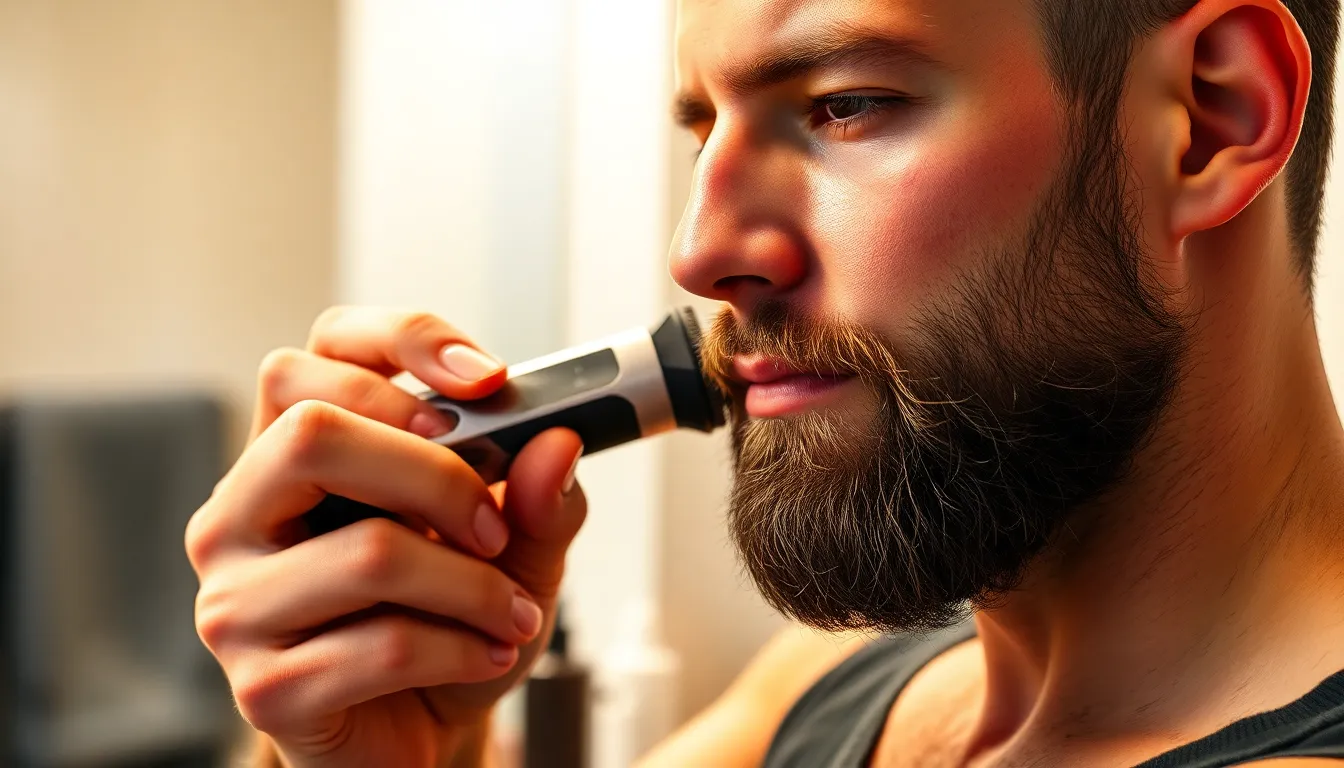
Stubble remains one of the most forgiving styles for men dealing with patchy facial hair. This approach transforms inconsistent growth patterns into an intentionally rugged, masculine look that requires minimal maintenance.
How to Achieve the Perfect Stubble Length
Start with a quality beard trimmer equipped with adjustable guard sizes to maintain consistent length across your entire face. We recommend keeping stubble between 1-5 mm for optimal coverage that disguises sparse areas effectively.
Adjust your trimmer settings based on your unique growth patterns to ensure even distribution throughout your facial hair. Different areas of your face may require slightly different lengths to create the illusion of uniform density.
Maintain your stubble regularly through consistent trimming every 2-3 days to prevent overgrowth in thicker areas. Regular maintenance keeps your stubble looking intentional rather than unkempt, especially in areas where growth varies significantly.
Test different lengths on various sections of your face to find the sweet spot where patchy areas blend seamlessly with fuller sections. Some men find that slightly longer stubble in sparse areas helps create better overall balance.
Tools and Techniques for Even Stubble Distribution
Invest in a high-quality beard trimmer with multiple guard options to taper your facial hair and create natural blending between thick and sparse areas. Quality trimmers help you achieve the uniform appearance that makes stubble work effectively for patchy beards.
Apply beard oil consistently to moisturize both your hair and the skin underneath, promoting healthier growth and improving the overall appearance of your stubble. Well-moisturized facial hair appears fuller and more even, helping to mask patchy areas.
Use specialized beard washes to maintain clean skin beneath your stubble, preventing irritation and ingrown hairs that can worsen the appearance of sparse areas. Clean, healthy skin provides the best foundation for even the patchiest facial hair.
Brush your stubble in the direction of natural hair growth using a boar bristle brush to train the hairs and create a more cohesive appearance. Proper brushing techniques help maximize the coverage you can achieve from existing hair growth.
Apply products strategically by focusing beard oils and balms on the sparsest areas to encourage healthier growth over time. While stubble requires minimal styling products, targeted application can improve both appearance and hair health.
The Soul Patch: Maximizing Limited Facial Hair

A soul patch offers an elegant solution for men seeking to maximize their limited facial hair growth. This focused approach creates a polished look that doesn’t require extensive coverage across the entire face.
Positioning and Shaping Your Soul Patch
Position your soul patch directly beneath the center of your lower lip for optimal visual impact. We recommend keeping the width no larger than the space between your canine teeth to maintain proper proportions. Trimming the patch into a neat rectangular or triangular shape creates clean definition that appears intentional rather than accidental.
Maintain consistent length throughout your soul patch using a quality beard trimmer set to 3-5mm. Regular trimming every 4-5 days prevents the patch from looking unkempt while allowing enough growth to establish presence. Edge the borders carefully with precision clippers to create sharp lines that enhance the overall appearance.
Monitor the natural growth pattern of your soul patch to determine its ideal shape. Some men achieve better results with a narrow vertical strip while others benefit from a wider horizontal rectangle. Experiment with different dimensions until you find the shape that complements your facial structure and existing hair growth.
Combining Soul Patches with Other Beard Elements
Pairing your soul patch with a mustache creates a balanced facial hair arrangement that draws attention to your stronger growth areas. We suggest maintaining similar lengths between both elements to achieve visual harmony across your facial hair. This combination works particularly well for men with sparse cheek coverage since it focuses attention on the central areas of the face.
Connect your soul patch to a goatee when you have sufficient chin hair growth for a more substantial appearance. This extended style creates the illusion of fuller facial hair coverage while still accommodating patchy areas on the sides. Blend the soul patch seamlessly into the goatee by gradually increasing hair length as you move toward the chin.
Consider adding sideburns to your soul patch combination when your temple hair grows well but cheek coverage remains sparse. This approach creates multiple focal points that distract from patchy areas while emphasizing the hair you can grow successfully. Keep all elements properly proportioned to avoid an unbalanced look that might highlight rather than minimize your patchy growth patterns.
The Chin Curtain: Working Around Patchy Cheeks

The chin curtain offers a strategic solution for men who struggle with sparse cheek coverage but maintain decent growth along their jawline. This style creates a connected, full appearance by focusing entirely on the hair that grows from ear to ear beneath the jaw.
Creating a Clean Chin Curtain Line
Establishing the upper border requires precision and the right tools for consistent results. We recommend using a quality beard trimmer to define this line just under your natural jawline, maintaining evenness across the entire length. Sharp definition separates this style from unkempt growth patterns that might appear accidental.
Regular shaving keeps the cheek areas clean while directing all attention to your strongest growth zone. Professional barbers suggest marking the desired line with a washable marker before trimming to ensure symmetry. Consistent maintenance every few days prevents the upper border from becoming uneven or growing too high toward the cheeks.
The lower edge needs equal attention to create that polished, intentional appearance. Trimming beneath the jawline removes stray hairs that extend too far down the neck. Quality results depend on maintaining both upper and lower boundaries with the same level of care and frequency.
Blending Techniques for Natural Transitions
Tapering creates seamless transitions between your sparse cheek areas and dense chin growth. We achieve this effect by gradually increasing hair length as it approaches the jawline, making the contrast less abrupt. Guarded trimmers provide the controlled length variations needed for professional looking results.
Blending starts with the shortest setting near patchy regions and progresses to longer lengths toward your strongest growth areas. This technique disguises uneven coverage by creating a natural flow rather than harsh lines. Strategic grading helps the eye focus on the fuller sections while minimizing attention to sparse zones.
Multiple guard lengths allow for precise control during the blending process. Working in small sections ensures even transitions and prevents accidentally removing too much hair from any single area. The gradual increase in length should span about half an inch to create that seamless, natural looking effect.
The Mustache Focus: Drawing Attention Upward
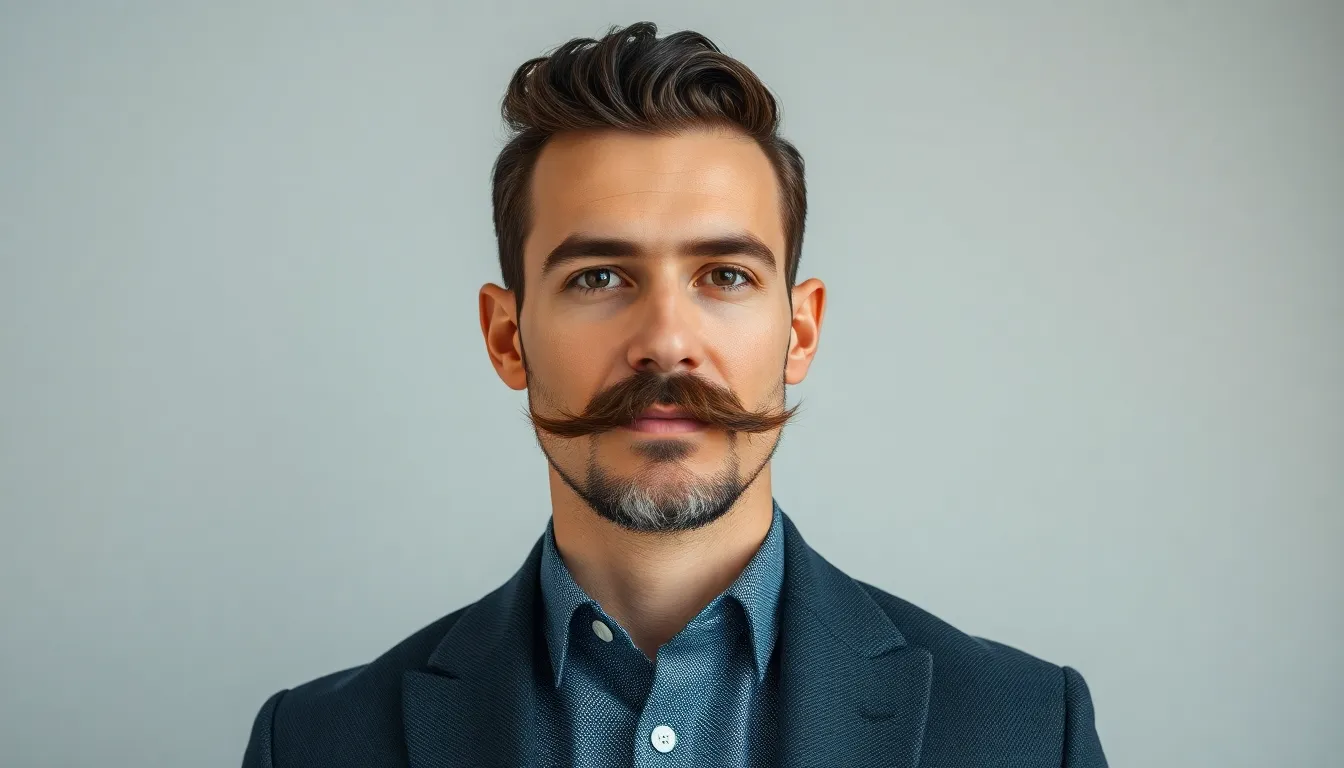
Drawing attention to your upper face creates an instant solution for patchy beard concerns. We’ve found that a well-crafted mustache paired with strategic facial hair choices transforms sparse growth into a confident, intentional look.
Classic Mustache Styles for Patchy Beards
Handlebar Mustache creates visual sophistication while diverting attention from uneven cheek growth. This distinctive style features elegant curves at each end that naturally draw eyes upward to your strongest facial hair area. We recommend starting with at least 3-4 months of mustache growth to achieve the proper length for shaping those signature curves.
Chevron Mustache follows your upper lip’s natural contours for a balanced appearance with patchy facial hair. This classic style maintains consistent width across the entire mustache, creating a strong horizontal line that complements sparse growth patterns below. Many men prefer this option because it requires less daily styling while still providing maximum visual impact.
Mustache and Goatee Combination maximizes your facial hair’s strongest growth areas while minimizing focus on patchy regions. This approach combines a well-defined mustache with chin hair, creating two focal points that work together harmoniously. We’ve observed this style works particularly well for men who experience sparse growth along their jawline but maintain decent coverage around the mouth and chin.
Grooming and Styling Your Mustache
Trimming schedules require consistency to maintain your mustache’s intended shape and proportions. We recommend trimming every 3-5 days using sharp grooming scissors or a precision trimmer with guard settings. Start by removing any hairs that extend beyond your upper lip’s edge, then shape the overall silhouette to match your chosen style.
Waxing techniques provide control and definition that enhance your mustache’s appearance throughout the day. Apply a small amount of mustache wax to slightly damp hair, working it through with your fingers before shaping. Quality wax products contain natural ingredients like beeswax and lanolin that offer hold without leaving residue or causing irritation.
Balancing proportions between your mustache and other facial hair creates visual harmony across your entire look. We suggest keeping your mustache width roughly equal to your goatee width when combining these elements. The length should complement rather than overpower your chin hair, typically maintaining a 2:3 ratio where the goatee appears slightly more prominent than the mustache.
Product application enhances both appearance and manageability of your mustache hair. Use beard oil daily to condition the hair and underlying skin, preventing dryness and promoting healthy growth. Apply the oil before styling products to create a smooth base that helps wax or balm distribute evenly throughout the hair.
The Van Dyke: Combining Goatee and Mustache Elements
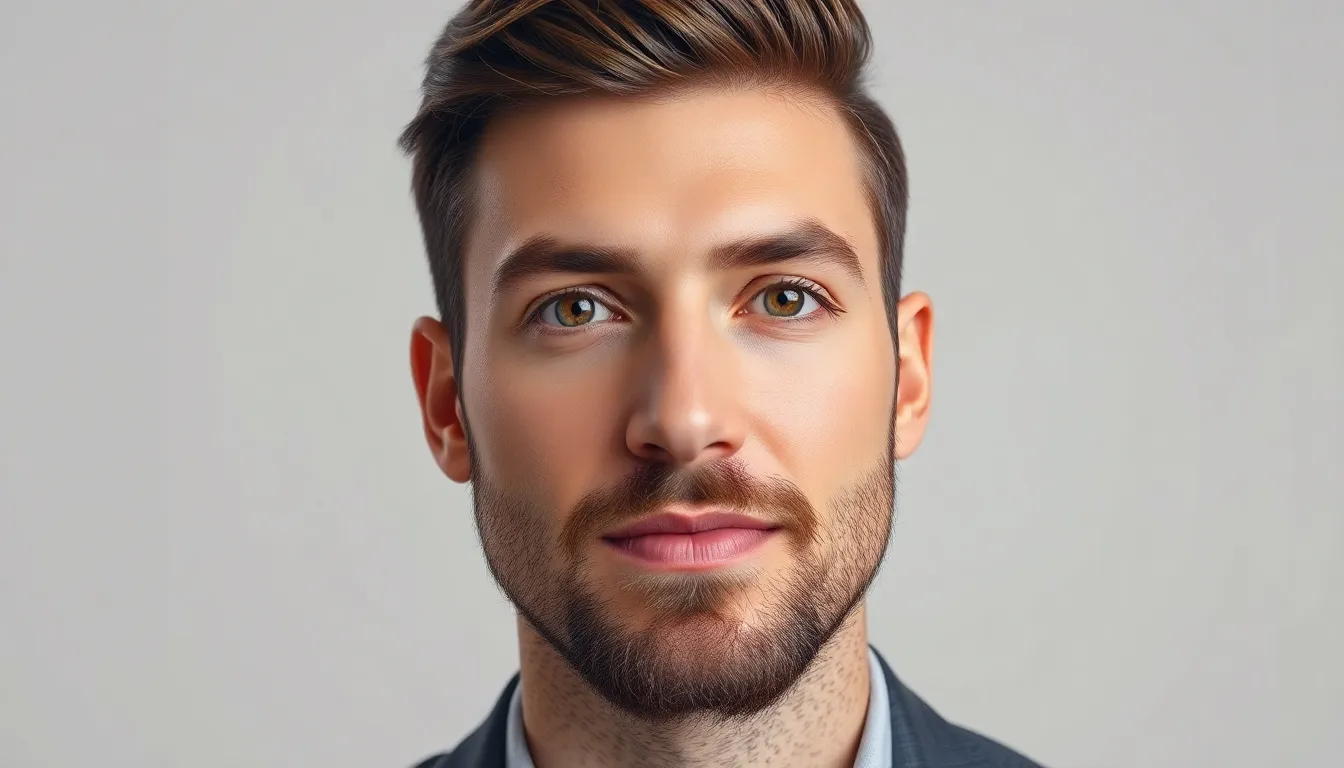
We’ve explored individual mustache and goatee approaches, but the Van Dyke style strategically combines both elements to create maximum impact for patchy beard growth. This distinguished look features a disconnected mustache paired with a well-defined goatee, allowing you to showcase your strongest growth areas while maintaining clean cheeks.
Achieving the Perfect Van Dyke Balance
Creating a balanced Van Dyke requires precise attention to proportions and clean lines between each element. Start by trimming your mustache to a neat, pointed shape with a slight gap between the hair and your nose base. Shape your goatee using sharp, symmetrical lines that define the beard area on your chin, ensuring both sides mirror each other perfectly.
Maintain completely clean-shaven cheeks to highlight the contrast between your facial hair elements and smooth skin. Regular maintenance every 2-3 days keeps the separation between your mustache and goatee clearly defined. Use a quality trimmer with precision guards to maintain consistent length across both areas.
Balance the proportions by keeping your mustache width roughly aligned with the outer edges of your goatee. Avoid making either element too dominant, as the Van Dyke’s appeal lies in the harmonious relationship between both components.
Common Mistakes to Avoid with This Style
Connecting your mustache and goatee accidentally ruins the Van Dyke’s distinctive separated appearance. Many men let hair grow in the space between these elements, which transforms the style into a regular goatee instead of maintaining the classic Van Dyke separation.
Neglecting regular cheek maintenance creates an unkempt appearance that undermines the style’s sophisticated look. Stubble on your cheeks draws attention away from the carefully crafted mustache and goatee combination.
Overgrowing either element disrupts the balanced proportions essential to this style. We’ve seen men let their goatee become too bushy or their mustache too wild, which overwhelms the refined aesthetic the Van Dyke is known for.
Asymmetrical shaping represents another common pitfall that makes the entire style appear careless. Take time to check both sides of your goatee in good lighting, ensuring the lines match precisely before finishing your grooming routine.
Strategic Trimming: Making Patchy Areas Less Noticeable

Strategic trimming transforms your patchy beard from a perceived flaw into a well-groomed advantage. We’ll show you how to work with your natural growth patterns to minimize sparse areas and create an intentional, polished look.
Identifying Your Strongest Growth Areas
Assess your facial hair regularly to determine where growth appears thickest and most consistent. Common strong zones include the chin area, mustache region, and sideburns, which typically develop more density than cheek areas in most men.
Map your growth patterns by observing your beard after 2-3 weeks of growth without trimming. Dense areas around the chin and jawline often provide the foundation for successful beard styling, while the mustache area can serve as a focal point to draw attention upward.
Document your strongest regions with photos taken from different angles to better understand your unique growth distribution. This assessment helps you choose styles that highlight your best features while strategically minimizing attention to sparser zones.
Trimming Techniques to Create Uniformity
Use trimmer guards to create gradual tapering from dense areas to sparser regions for a natural appearance. Start with longer guard settings on your strongest growth zones, then gradually reduce the length as you move toward patchy areas to create seamless transitions.
Taper sparser areas shorter than denser sections using this gradient approach, which visually reduces the contrast between thick and thin zones. This technique creates the illusion of more even coverage across your entire beard area.
Position your main beard bulk around the chin or mustache to draw focus away from weaker growth zones naturally. Clean lines along your neckline and cheek line maintain a neat, intentional appearance that suggests careful grooming rather than sparse growth.
Brush hair in the direction of natural growth before each trimming session to ensure precise cuts and make sparse areas appear fuller. This directional grooming technique allows you to see exactly how your hair lies and trim accordingly for maximum visual impact.
Maintain regular trimming schedules with frequent, light adjustments to prevent patchy spots from becoming more pronounced over time. Weekly touch ups keep your beard shape sharp and your chosen style looking deliberate rather than unkempt.
Grooming Products That Help Patchy Beard Styles
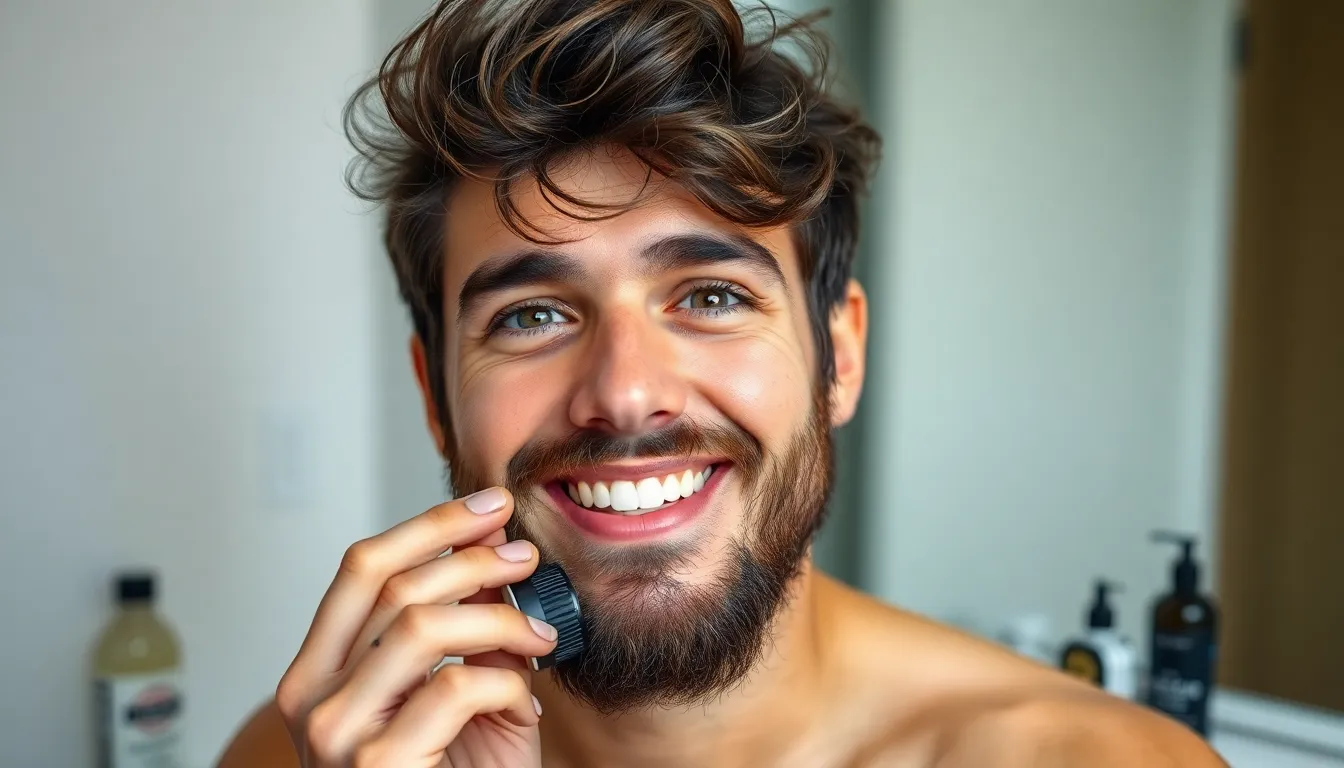
Strategic product selection transforms patchy facial hair from a challenge into a manageable style advantage. Quality grooming products enhance what you already have while creating the illusion of fuller coverage.
Beard Oils and Their Benefits for Sparse Hair
Moisturizing properties in beard oils create the foundation for healthier hair growth by nourishing both the hair follicles and underlying skin. Quality oils like jojoba, argan, and sweet almond penetrate deeply to soften coarse hairs and reduce brittleness that makes sparse areas more noticeable.
Shine enhancement from regular oil application makes existing hairs appear fuller and more prominent. This optical effect helps patchy areas blend more naturally with denser growth zones by reflecting light uniformly across your facial hair.
Growth promotion occurs when beard oils maintain optimal skin conditions beneath your facial hair. Healthy follicles surrounded by well moisturized skin produce stronger, more resilient hairs that contribute to overall beard density over time.
Application technique matters significantly for patchy beards since targeted use maximizes results. We recommend applying 3-4 drops to clean, slightly damp facial hair, focusing extra attention on sparse areas where the oil can penetrate more easily.
Styling Products for Better Coverage and Hold
Beard balms provide medium hold while offering coverage benefits that make patchy areas less obvious. These products contain natural waxes and butters that coat individual hairs, creating volume and helping stray hairs stay in formation throughout the day.
Stronger hold options like beard wax excel at training mustache hairs and managing exact problem areas where patchiness disrupts your desired style. Beeswax based products offer firm control for shaping techniques that redirect attention from sparse zones.
Conditioning treatments through specialized beard washes and leave in conditioners maintain hair health while reducing the itchiness and dandruff that often accompany patchy growth patterns. Clean, healthy facial hair always appears fuller than neglected hair.
Strategic layering combines multiple products for maximum effect in patchy beard management. Start with beard oil for moisture, add balm for hold and coverage, then finish with targeted wax application on areas requiring extra control or definition.
Conclusion
Patchy beard growth doesn’t have to limit your style options. We’ve shown you that strategic grooming and the right approach can transform sparse facial hair into a confident signature look.
From classic goatees to well-maintained stubble these styles work with your natural growth patterns rather than against them. The key lies in understanding your unique beard map and choosing techniques that highlight your strongest areas.
Remember that consistency matters most. Regular trimming quality products and proper maintenance will keep any patchy beard style looking intentional and polished. Your facial hair journey is unique – embrace it and make it your own.
Frequently Asked Questions
Can I still have a stylish beard if my facial hair grows in patches?
Absolutely! About 70% of men experience patchy beard growth at some point. Rather than fighting against your natural growth patterns, you can embrace them by choosing beard styles that complement your specific growth areas. Strategic trimming and the right styling approach can turn patchy growth into a unique, confident signature look.
What causes patchy beard growth?
Genetics play the biggest role, determining up to 85% of your beard density and growth patterns. Hormonal factors like testosterone and DHT levels also influence growth. Age is another factor, with most men reaching peak beard density between ages 25-35. Follicle distribution varies among ethnic groups and individuals too.
What’s the best beard style for sparse cheek coverage?
The classic goatee is excellent for men with sparse cheek coverage. It focuses attention on your stronger growth areas around the chin and mouth. You can also try a chin curtain style, which works well if you have decent growth along your jawline but sparse cheeks.
How do I maintain the perfect stubble with patchy growth?
Keep stubble between 1-5mm length using a quality beard trimmer. Trim every 2-3 days to maintain an intentional look. Apply beard oil for moisture, use specialized beard washes, and brush stubble in the direction of natural hair growth. This approach is very forgiving for patchy areas.
Should I consider a mustache-only style for patchy beards?
Yes! A well-groomed mustache can draw attention upward and away from patchy areas. Classic styles like handlebar or chevron mustaches work well. You can also combine a mustache with a goatee (Van Dyke style) to maximize your strongest growth areas while minimizing focus on sparse regions.
What grooming products help with patchy beards?
Beard oils are essential as they nourish follicles and enhance fullness appearance. Beard balms and waxes provide hold and coverage, making sparse areas less noticeable. Use conditioning treatments and layer products strategically. Apply products to sparse areas to promote healthier growth and improve overall appearance.
How often should I trim my patchy beard?
Maintain a regular trimming schedule every 2-3 days for stubble, or weekly for longer styles. Use trimmer guards for gradual tapering and focus on creating clean lines. Position bulk around your chin or mustache area where growth is strongest, and trim directionally to keep your beard looking intentional.
